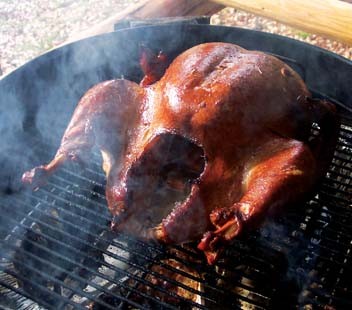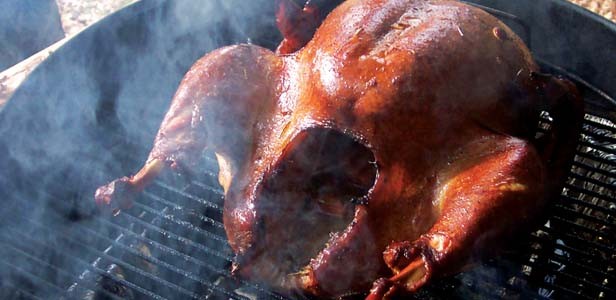Tired of the same old bird for the holidays? Give your turkey an extreme makeover by taking the cooking – and the party – outside.
“A turkey smoke-roasted on the grill tastes better, thanks to the smoke flavor,” says Steve Raichlen, author of The Barbecue Bible and How to Grill and host of the PBS series “Primal Grill.” “It frees up your oven for other dishes. It gives you an excuse to spend the afternoon outdoors, gathered around the grill drinking beer or wine with your buddies.”
And get ready for the “oohs” and “aaahs” when you present a turkey smoked to perfection: “a gorgeous, plump, mahogany colored bird – the skin crackling crisp, the meat tender and juicy, the whole shebang perfumed with wood smoke,” says Raichlen.
“Guests are totally amazed because they would never guess that a whole turkey can be cooked outdoors,” says Dave DeWitt, editor of Fiery-Foods.com. It also nicely avoids the large amounts of oil used in frying turkeys.
Among the options for cooking a turkey outdoors are grilling, rotisserie and smoking in a ceramic smoker. DeWitt favors the rotisserie method “because it’s so versatile, you don’t need to worry about flipping the meat over, like you would with grilling, the heat is even and you don’t have to tend to it very much.”
DeWitt is not keen on cutting up the bird to cook on the grill, which he says takes away the beauty of a whole bird in the center of the table and may lead to burning the bird if you step away for too long to watch the game.
Raichlen favors cooking a whole turkey in a ceramic smoker or on the charcoal grill, which he says “is best for the reason that it’s easy to smoke on a charcoal grill and very difficult to smoke on a gas grill.” (See Raichlen’s recipe, below).
Here are several of their tips to cooking your turkey outdoors:
Assemble Your Tools
Raichlen suggests a barbecue injector, which enables you to inject some of the marinade into the turkey. Consider food gloves for handling the turkey. Both Raichlen and DeWitt say a meat thermometer is essential.
Smoke ‘Em Out
Raichlen prefers natural lump charcoal, not briquettes, which can have a chemical taste if not properly lit. Soak wood chips before placing them on the charcoal once the ash is well formed. DeWitt prefers fruitwood, such as apple, which gives the turkey a mild smoky flavor.
“Most of the barbecue flavor comes from the fat that drips from the bird onto the hot coals or wood, which interacts with the smoke and rises to coat the bird.”
There’s the Rub
DeWitt likes using a low-sodium rub on his smoked turkey. Make your own rub from paprika, garlic and ground chili pepper. “Salt draws out the fluids from the turkey and you want your turkey as moist as possible,” he says
Pause Before Serving
Be patient. “Let the bird rest for 20 minutes before carving to let the juices redistribute themselves,” Raichlen says. “It will be much moister.”
Bourbon-Injected Barbecued Turkey
Adapted from BBQ USA by Steven Raichlen
For the injector sauce:
- 2 tablespoons salted butter
- 1/3 cup chicken stock (preferably homemade), at room temperature
- 2 tablespoons bourbon
- 1 tablespoon of your favorite commercial barbecue rub (Note: Finely grind in a spice mill or coffee grinder if the rub has any coarse bits or spices in it so it doesn’t clog the injector)
For the turkey:
- 1 turkey (8 to 10 pounds), thawed if frozen
- 4 tablespoons your favorite commercial barbecue rub
- 1 tablespoon melted butter
You’ll also need:
- A marinade injector
- 3 cups of wood chips, preferably apple, soaked for 1 hour in water to cover, then drained
1. To make the injector sauce, melt the butter in a small saucepan. Add the stock, bourbon and rub and whisk to mix. Let cool to room temperature.
2. Remove the packet of giblets from the neck or body cavity of the turkey and set aside for another use. Remove and discard the fat just inside the cavities of the turkey. Rinse the turkey, inside and out, under cold running water, then blot dry, inside and out, with paper towels. Season the inside of both cavities with 2 tablespoons of the rub.
3. Fill the injector with the injector sauce. To do this, push the plunger all the way down, place the tip of the needle in the sauce, and slowly draw the plunger up. The syringe will fill with sauce. Inject the sauce into the turkey breast, thighs, and drumsticks. Don’t be surprised if a little sauce squirts out; this is okay.
4. Set up the grill for indirect grilling and preheat to medium. If using a gas grill, place all of the wood chips or chunks in the smoker box or in a smoker pouch and run the grill on high until you see smoke, then reduce the heat to medium. If using a charcoal grill, place a large drip pan in the center, preheat the grill to medium, then toss 1 cup of the wood chips or chunks on the coals.
5. When ready to cook, place the turkey, breast side up, in the center of the hot grate, over the drip pan and away from the heat. Put the lid down and cook the turkey until the skin is nicely browned and the meat is cooked through, 2-1/2 to 3 hours. To check for doneness, insert an instant-read thermometer in the thickest part of a thigh but not so that it touches the bone. The internal temperature should be about 165 degrees F. If the wing tips start to burn, cover them loosely with aluminum foil; if the skin starts to brown too much, cover the bird loosely with aluminum foil.
6. Transfer the grilled turkey to a platter, cover it loosely with aluminum foil and let it rest for 10 minutes. Serves 8 to 10.
Looking for an unusual brined take on the more traditional roast turkey recipe? See Julianne Glatz’s, “Roasting a better bird,” Nov. 12.























